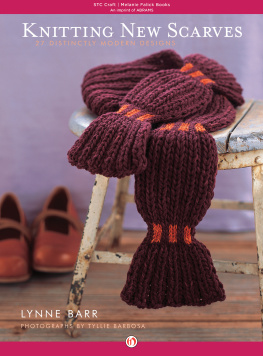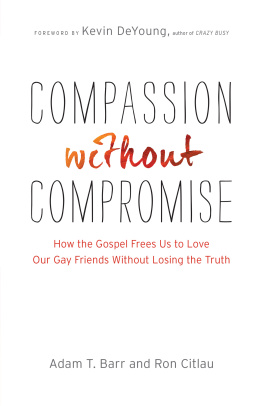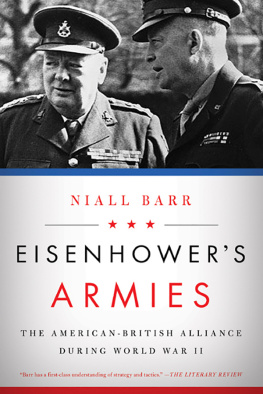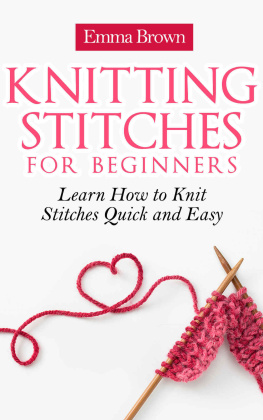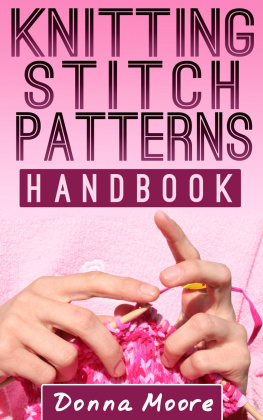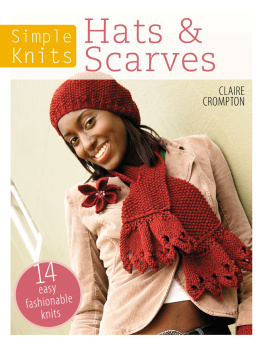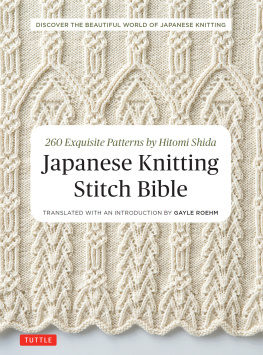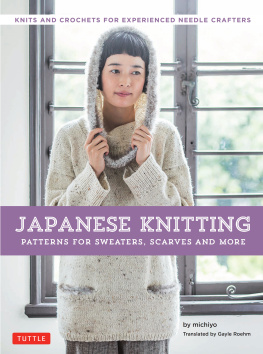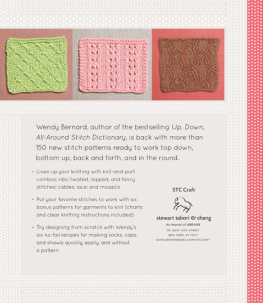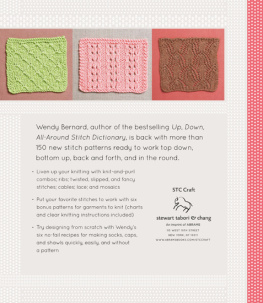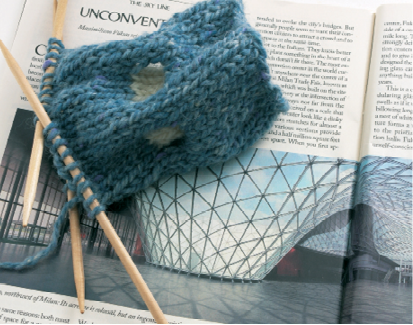Table of Contents
Published in 2007 by Stewart, Tabori & Chang
An imprint of ABRAMS
Text copyright 2007 by Lynne Barr
Photographs copyright 2007 by Tyllie Barbosa
(except photograph on page 7 and step-by-step photographs
on pages 21, 24, 33-35, 42, 47, 55, 59-60, 69, 84, 89,
110, 113, 116, 128-141).
Photographs on page 7 and step-by-step photographs copyright 2007 by Lynne Barr
All rights reserved. No portion of this book may be reproduced, stored in a retrieval system, or transmitted in any form or by
any means, mechanical, electronic, photocopying, recording,
or otherwise, without written permission from the publisher.
Library of Congress Cataloging-in-Publication Data:
Barr, Lynne.
Knitting new scarves / by Lynne Barr.
p. cm.
ISBN: 978-1-4532-6820-9
1. KnittingPatterns. 2. Scarves. I. Title.
TT825.B2975 2007
746.43'2041dc22
2006101806
Editor: Melanie Falick
Designer: Sarah Von Dreele
Production Manager: Jacqueline Poirier
The text of this book was composed in Futura
and Mrs Eaves.
Printed and bound in China
10 9 8 7 6 5
Stewart, Tabori & Chang books are available at special
discounts when purchased in quantity for premiums and
promotions as well as fundraising or educational use. Special editions can also be created to specification. For details,
contact specialsales@abramsbooks.com or the address below.


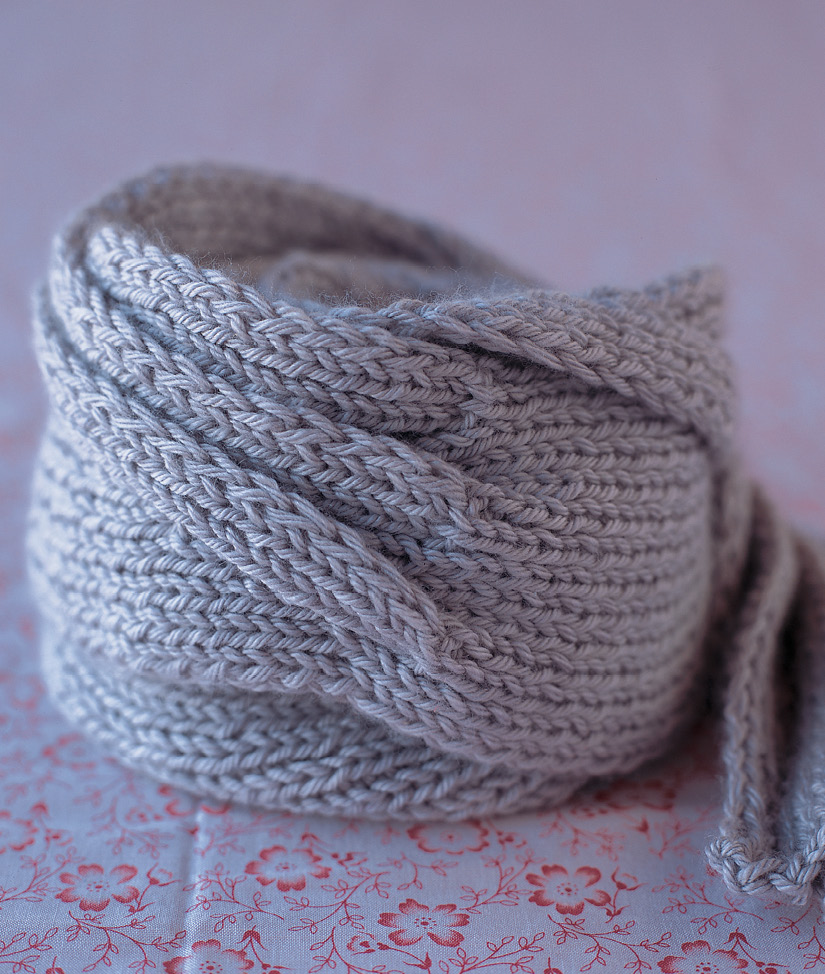
Introduction
It has been a long time since Ive taught a knitting workshop, but while writing this book, Ive thought often of students from a beginning knitting class. I dont think my class was what they expected and I was certainly surprised by them as well. At our first meeting I announced that they were going to design their own projects. They learned to cast on, knit, and purl. They learned to recognize knit and purl stitches, and how to distinguish between them, whether looking at an actual piece of knitting, or at pictures of stitch patterns in a book.
The process of becoming knit literate had begun. As soon as they learned these basics, I encouraged them to become creative knitters. They would return to class with smiles from ear to ear and samples of their discoveries. At one of the early classes, one student surprised me when he unrolled about three feet of stitch samples, comprised entirely of different combinations of knit and purl stitches. Some were the common checkerboard-like moss stitch and rib varieties, but a few patterns may have been uniquely his. Whatever knitting mishaps occurred for these new knittersdropped or twisted stitches, unintentional decreases or increaseswe looked at them and figured out what had happened. They weren't mistakes; they were opportunities.
My hope for this book is that it inspires other knitters to pick up yarn and needles and just play, finding ways to make new forms and discover new connections. When you look at one of my scarves, ask yourself, What if? Its a question I constantly ask myself when playing with an idea. You might notice similarities between some of the scarf directions, and then how a single change created a whole new look. For instance, when I completed . The new scarf has a subtler curve, and instead of a striped appearance, it has become a multicolored patchwork. While knitting your new scarves, I invite you to try other possibilities and to ask some of the other questions I ask myself: What if I switch these stitches, or turn in this direction instead of that, or divide some of these stitches instead of all of them, or move stitches forward instead of backward? The possibilities are endless!
Knitting is certainly as much about a process as a finished product. Otherwise, we would all purchase finished knit items that probably cost less these days than purchasing yarn. I do take pride in the scarves I designed and knit for this book, but it doesn't come close to the excitement I felt when I would wake at five in the morning with an idea I wanted to try. After a quick pass through the kitchen to make a cup of coffee, I was eager to pick up needles and yarn to work out my vision. It is my hope that knitters who use this book will be inspired to take chances , and will use these patterns as a leaping off point for their own exciting creations.
While friends were testing my patterns, they would often ask, How did you think of this one? More often than not, my answer was the name of a building. I was probably influenced more by architecture than anything else. When excited by a building, I want to travel there to see it and experience the space. Some of the scarves in this book are the result of me working out those desires in yarnsee , which was inspired by a freeform house in California. The knitting in the photo above was inspired by a building in Milan that has an organically-shaped glass ceiling, the center of which curves to the floor, creating a funnel shape in the interior space. The sky and clouds above it appear to be pulled into the funnel, connecting them to the interior floor.
Translating geometric shapes from architecture, normally used for their structural rigidity, into the soft medium of yarn provided me a mild challenge. My greater challenge was to convert these now pliable forms into scarves that would wrap around a neck without looking preposterous! The greatest challenge of all was forcing myself to put down my yarn and needles in order to write the patterns. I hope you enjoy them, but mostly I hope they help you to kindle new ideas of your own.
Before You Start
A Note on Techniques
Near the start of each pattern you will see a list of the techniques required. All of these techniquesthere are ten of themare explained in detail at the back of the book . Some of them, like Intarsia and Short Row Shaping, are very common; others, like Rib Division (a way of dividing up knit and purl stitches so they can be worked separately for a while and then can be reconnected later) and Interlocking Stitches (a method for attaching stitches from a finished piece to stitches live on a needle) may be new to many knitters. All of these techniques are used in scarves throughout the book. In addition, within some of the patterns, you will find further instruction for techniques that are only used for that specific scarf (though, of course, you can choose to apply them in your own designs as you like).
To avoid having to flip back and forth between the actual scarf patterns and the technique instructions given at the back of the book, I suggest that you photocopy the technique pages you need from the back and then place them next to the pattern instructions you are following. Before too long the new techniques will become second nature and you will not need the photocopies, but until that happens, I think you will find this setup helpful.
A Few Words About Ribs
Since my primary interest was in form and structure, I didnt spend time creating decorative stitch patterns for the scarves. Most of them are simply worked in Garter for its ability to hold a shape, and Rib for its efficacy in shaping by dividing and combining stitches. I dont have anything to add about Garter, but I do have a few words about Ribs.
Next page
